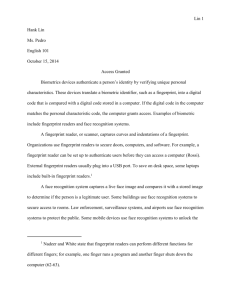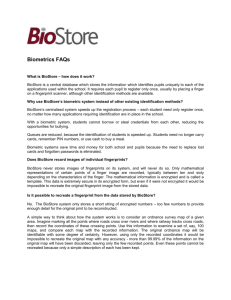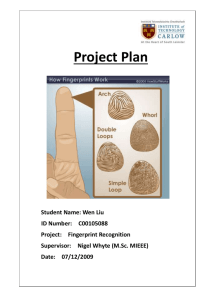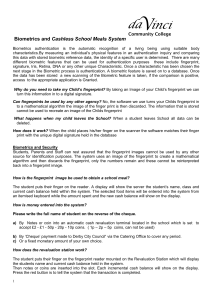(BLIND AUTHENTICATION), K.P. Mani Annand, S
advertisement
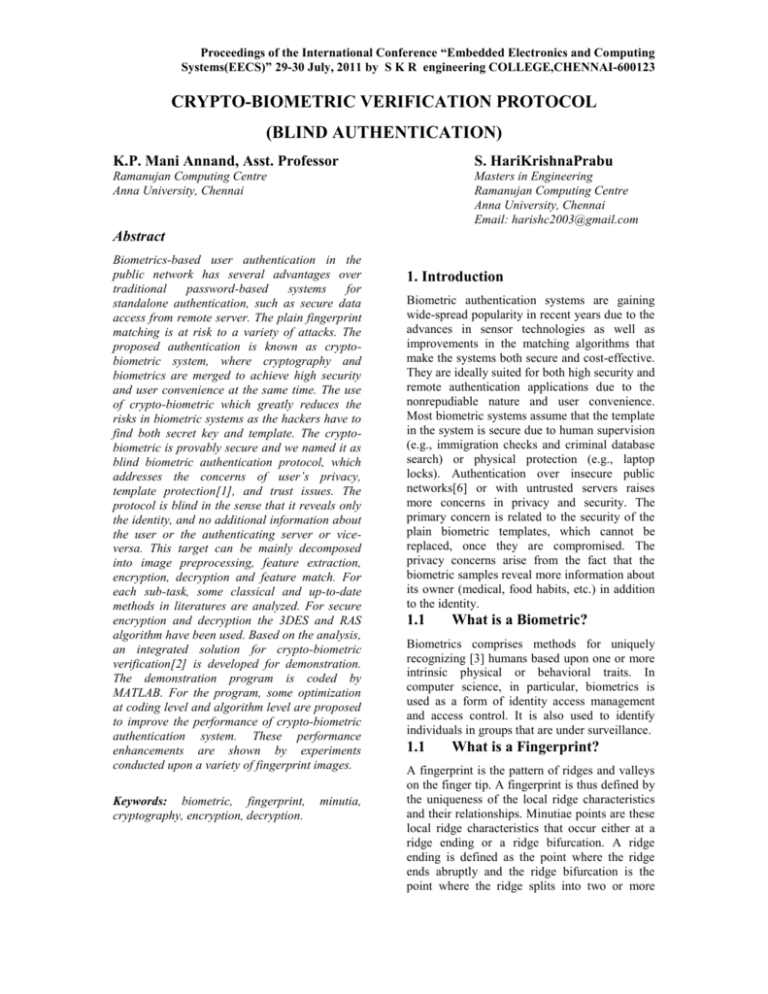
Proceedings of the International Conference “Embedded Electronics and Computing Systems(EECS)” 29-30 July, 2011 by S K R engineering COLLEGE,CHENNAI-600123 CRYPTO-BIOMETRIC VERIFICATION PROTOCOL (BLIND AUTHENTICATION) K.P. Mani Annand, Asst. Professor S. HariKrishnaPrabu Ramanujan Computing Centre Anna University, Chennai Masters in Engineering Ramanujan Computing Centre Anna University, Chennai Email: harishc2003@gmail.com Abstract Biometrics-based user authentication in the public network has several advantages over traditional password-based systems for standalone authentication, such as secure data access from remote server. The plain fingerprint matching is at risk to a variety of attacks. The proposed authentication is known as cryptobiometric system, where cryptography and biometrics are merged to achieve high security and user convenience at the same time. The use of crypto-biometric which greatly reduces the risks in biometric systems as the hackers have to find both secret key and template. The cryptobiometric is provably secure and we named it as blind biometric authentication protocol, which addresses the concerns of user’s privacy, template protection[1], and trust issues. The protocol is blind in the sense that it reveals only the identity, and no additional information about the user or the authenticating server or viceversa. This target can be mainly decomposed into image preprocessing, feature extraction, encryption, decryption and feature match. For each sub-task, some classical and up-to-date methods in literatures are analyzed. For secure encryption and decryption the 3DES and RAS algorithm have been used. Based on the analysis, an integrated solution for crypto-biometric verification[2] is developed for demonstration. The demonstration program is coded by MATLAB. For the program, some optimization at coding level and algorithm level are proposed to improve the performance of crypto-biometric authentication system. These performance enhancements are shown by experiments conducted upon a variety of fingerprint images. Keywords: biometric, fingerprint, cryptography, encryption, decryption. minutia, 1. Introduction Biometric authentication systems are gaining wide-spread popularity in recent years due to the advances in sensor technologies as well as improvements in the matching algorithms that make the systems both secure and cost-effective. They are ideally suited for both high security and remote authentication applications due to the nonrepudiable nature and user convenience. Most biometric systems assume that the template in the system is secure due to human supervision (e.g., immigration checks and criminal database search) or physical protection (e.g., laptop locks). Authentication over insecure public networks[6] or with untrusted servers raises more concerns in privacy and security. The primary concern is related to the security of the plain biometric templates, which cannot be replaced, once they are compromised. The privacy concerns arise from the fact that the biometric samples reveal more information about its owner (medical, food habits, etc.) in addition to the identity. 1.1 What is a Biometric? Biometrics comprises methods for uniquely recognizing [3] humans based upon one or more intrinsic physical or behavioral traits. In computer science, in particular, biometrics is used as a form of identity access management and access control. It is also used to identify individuals in groups that are under surveillance. 1.1 What is a Fingerprint? A fingerprint is the pattern of ridges and valleys on the finger tip. A fingerprint is thus defined by the uniqueness of the local ridge characteristics and their relationships. Minutiae points are these local ridge characteristics that occur either at a ridge ending or a ridge bifurcation. A ridge ending is defined as the point where the ridge ends abruptly and the ridge bifurcation is the point where the ridge splits into two or more Proceedings of the International Conference “Embedded Electronics and Computing Systems(EECS)” 29-30 July, 2011 by S K R engineering COLLEGE,CHENNAI-600123 branches. Automatic minutiae detection becomes a difficult task in low quality fingerprint images where noise and contrast deficiency result in pixel configurations similar to that of minutiae. This is an important aspect that has been taken into consideration in this project for extraction of the minutiae with a minimum error in a particular location. bifurcations. Here 1024 bits RSA have been implemented. 2.1 Blind Authentication Modules A typical biometric system comprises of several modules. The sensor module acquires the raw biometric data of an individual in the form of an image, video, audio or some other signal. The feature extraction module operates on the biometric signal and extracts a salient set of features to represent the signal; during user enrolment the extracted feature set, labeled with the user’s identity[4], and encrypt it using RAS algorithm and stored in the biometric system is known as a encrypt-template. Figure 1.1 Two important minutia features 1.2 What is Blind Authentication? The crypto-biometric is provably secure and named it as blind biometric authentication protocol, which addresses the concerns of user’s privacy, template protection[8], and trust issues. The protocol is blind in the sense that it reveals only the identity, and no additional information about the user or the biometric authenticating server or vice-versa. This system present the authentication framework that achieves the goal using any biometric, and prove that the information exchanged between the client and the server does not reveal anything other than the identity of the client 2. Methodology The proposed system is implemented with minutiae-based matching. This is the most popular and widely used technique, being the basis of the fingerprint comparison made by fingerprint examiners. Minutiae[5] are extracted from the two fingerprints and stored as sets of points in the two-dimensional plane. Minutiaebased matching essentially consists of finding the alignment between the template and the input minutiae sets that result in the maximum number of minutiae pairings. 3DES is used to encrypt the fingerprint binary image. 3DES uses three keys to encrypt and decrypt data, so effective key length is 168 bits. RSA is used to encrypt the fingerprint template after find the minutiae terminations and Figure 2.1 Crypto-biometric authentication system architecture The matching module will decrypt the template and compares the feature set extracted during authentication with the enrolled template(s) and generates match scores. The decision module processes these match scores in order to either determine or verify the identity of an individual. Thus, in crypto-biometric system several different levels of attacks that can be launched (i) A fake biometric trait such as an artificial finger may be presented at the sensor, (ii) illegally intercepted data may be resubmitted to the system, (iii) the feature extractor may be replaced by a Trojan horse program that produces pre-determined feature sets, (iv) legitimate feature sets may be replaced with synthetic feature sets, (v) the matcher may be replaced by a Trojan horse program that always outputs high scores thereby defying system security, (vi) the templates stored in the database may be modified or removed, or new templates may be introduced in the database, (vii) the data in the communication channel between various modules of the system may be altered. Proceedings of the International Conference “Embedded Electronics and Computing Systems(EECS)” 29-30 July, 2011 by S K R engineering COLLEGE,CHENNAI-600123 3. Implementation We have concentrated our implementation on Minutiae based method. In particular we are interested only in two of the most important minutia features i.e. Ridge Ending and Ridge bifurcation. (Figure 3.1) Figure 3.2 Fingerprint binarization Figure 3.1(a) Bifurcation Ridge Ending, (b) Ridge The outline of our approach can be broadly classified into 2 stages - Minutiae Extraction and Minutiae matching. The system takes in 2 input fingerprints to be matched and gives a percentage score of the extent of match between the two. Based on the score and threshold match value it can distinguish whether the two fingerprints match or not. 3.1 Related Work Pre-Processing The input image is segmented from the background which ensures the removal of noise. For this, the whole image is divided into blocks of size 16×16 and the variance of each block is computed. The variance is then compared with the threshold value. If the variance of a block is less than the threshold value, then it is deleted from the original figure. This process is carried out for the whole image. The image obtained from the above step is then normalized to get the desired variance of the given image. The normalized image is given by The estimation of the orientation of the image is then carried out as the next step. The whole image is divided into blocks of size 16×16 and the local orientation in the figure is computed by where θ(i, j) is the least square estimate of the local ridge orientation at the block centered at pixel (i, j). Figure 3.3 Fingerprint thinning where denotes the gray-level value at pixel (i, j), M and VAR denote the estimated mean and variance of respectively and denotes the normalized gray-level value at pixel (i, j). and are the desired mean and variance values respectively. The angles between the blocks are then smoothened by passing the image through a low pass filter as follows. Proceedings of the International Conference “Embedded Electronics and Computing Systems(EECS)” 29-30 July, 2011 by S K R engineering COLLEGE,CHENNAI-600123 Figure 3.5 Region of Interest to match Figure 3.4 Fingerprint minutiae assing The following method is adopted for the calculation of the frequency of the local blocks. X-signatures of each block are computed along the direction perpendicular to the orientation angle in each block. The window used for this purpose is of size 16×32. The frequency is then computed by the distance between the peaks obtained in the X-signatures. The window for this is given by the formula In general, the frequency of image constitutes has a certain frequency for the hole image and hence the above step can be omitted if the global frequency of the given figure is known. As the next step, each block is filtered along the direction of the orientation angle using the value of the frequency obtained for each block. A Gabor filter is used for this process and a suitable value of local variances is taken for carrying out the process of filtering. A Gabor filter takes care of both the frequency components as well as the spatial coordinates. The inputs required to create a Gabor mask are frequency, orientation angle and variances along x and y directions. Filtering is done for each block using the local orientation angle and frequency. Pre-processing of the image is completed by the steps as mentioned and the enhanced image is obtained. Minutiae Extraction The next step after enhancement of the image is the extraction of minutiae. The enhanced image is binarised first in this step. The skeleton of the image is then formed. The minutiae points are then extracted by the following method. The binary image is thinned as a result of which a ridge is only one pixel wide. The minutiae points are thus those which have a pixel value of one (ridge ending) as their neighbor or more than two ones (ridge bifurcations) in their neighborhood. This ends the process of extraction of minutiae points. Figure 3.6 Fingerprint minutia extractions Encrypt the Template A binary image has only two different pixel values. This makes the image highly correlated and difficult to encrypt. The encryption should also be strong enough so that the unintended recipients or interceptor could not understand the image content. Visual cryptography is very different from traditional cryptography scheme. Proceedings of the International Conference “Embedded Electronics and Computing Systems(EECS)” 29-30 July, 2011 by S K R engineering COLLEGE,CHENNAI-600123 In visual cryptography no password is used for encryption and decryption. The security of the visual cryptography depends on the trust not on the strength of the encryption scheme. Here visual cryptography as a means of secure cryptography. Because, its concept of security on trust is itself against the concept of security. the original binary image from the shares. If o is not 0 or 1 the original image will be properly decrypted removing all the background noises from the shares but its size will be equal to the size of the shares. Minutiae Matching An elastic string ( , , ) match algorithm is used to find number of matched minutia pairs among I1’ & I2’. According to the elastic string match algorithm minutia mi in I1’ and a minutia mj in I2’ are considered "matching," if the spatial distance (sd) between them is smaller than a given tolerance r0 and the direction difference (dd) between them is smaller than an angular tolerance O0. Figure 3.7 Fingerprint encryption Decrypt the Template Decryption is simple, ones the two shares are received by the intended receiver, This system can decrypt the information by simply stacking the two transparencies, which is equivalent to simply adding the two shares, i.e, y1 and y2. The user may complain that there are lots of background noise in the decrypted image. Also, he may complain that the system want the exact original binary image from the two shares. The reason, why this blind authentication system added vdecrypt function is to get them. y=decrypt(y1,y2,o) sd = dd ≤ ø0 Let mm(.) be an indicator function that returns 1 in the case where the minutiae mi and mj match according to above equations. mm(mi,mj)= Now the total number of matched minutiae pair given by, num (matched minutiae) = and final match score is given by, Match Score Figure 3.8 Fingerprint decryption y1 and y2 are the two encrypted components or shares and o is option of decryption. If o =0, then the decryption result would be similar to the one you would be getting by adding or stacking the two shares. If o=1, then it will exactly decrypt ≤ r0 = Figure 3.9 Fingerprint minutiae match = Proceedings of the International Conference “Embedded Electronics and Computing Systems(EECS)” 29-30 July, 2011 by S K R engineering COLLEGE,CHENNAI-600123 4. Experimental Result False Rejection Rate (FRR): For an image database, each sample is matched against the remaining samples of the same finger to compute the False Rejection Rate False Acceptance Rate (FAR): Also the first sample of each finger in the database is matched against the first sample of the remaining fingers to compute the False Acceptance Rate. Table 4.2 Fingerprint encryption time elapsed for different samples Samples Elapsed Time (Sec) FPT1 0.019151 FPT2 0.019142 FPT3 0.019114 Following is the distribution curve obtained after experiments. 20 The Elapsed time for the different Fingerprint template encryption and decryption is as follows: In our experiments FAR and FRR values were 10-20% approximately. Thus at a threshold match score of about 50 the verification rate of the algorithm is about 80-90%. 18 16 14 12 10 FAR 8 FRR 6 The relatively low percentage of verification rate is due to poor quality of images in the database and the inefficient matching algorithm which lead to incorrect matches. 5. Summary and Future Work 4 2 0 0 5 10 15 20 25 Figure 4.1 FAR vs FRR Following is the Details of a sample Fingerprint Template minutia values for Terminations and Bifurcations Table 4.1 Fingerprint minutiae details Number of Terminations: 11 Number of Bifurcations: 5 Terminations : X Y Angle The proposed blind authentication is extremely secure under a variety of attacks and can be used with a wide variety of biometric traits. Protocols are designed to keep the interaction between the user and the server to a minimum with no resort to computationally expensive protocols such as secure multiparty computation (SMC). As the verification can be done in real-time with the help of available hardware, the approach is practical in many applications. Possible extensions to this work include secure message passing in the public network using secure enrollment protocols and encryption methods to reduce computations 206 126 -0.79 138 147 -1.05 137 163 2.09 REFERENCES 227 173 -1.57 205 174 -2.09 162 176 -2.36 106 185 -1.57 118 198 2.62 102 202 -1.05 163 211 -2.09 99 234 -1.05 [1] A. K. Jain, K. Nandakumar, and A. Nagar, “Biometric template security,” EURASIP, vol. 8, no. 2, pp. 1–17, 2008. [2] M. Upmanyu, A. M. Namboodiri, K. Srinathan, and C. V. Jawahar, “Efficient biometric verification in the encrypted domain,” in 3rd Int. Conf. Biometrics, Jun. 2009, pp. 906– 915. [3] A. K. Jain, A. Ross, and S. Prabhakar, “An introduction to biometric recognition,” IEEE Trans. Circuits Syst. Video Technol., vol. 14, no. 1, pp. 4–20, Jan. 2004. [4] Delac, K., Grgic, M. (2004). A Survey of Biometric Recognition Methods. Bifurcations : X Y Angle 2 Angle 3 -2.36 0.52 2.62 -1.57 0.52 172 -2.62 1.57 -1.05 118 217 2.62 -1.57 0.52 116 229 -2.62 2.09 0.00 130 95 88 101 189 Angle 1 2.36 Proceedings of the International Conference “Embedded Electronics and Computing Systems(EECS)” 29-30 July, 2011 by S K R engineering COLLEGE,CHENNAI-600123 [5] White Paper - Identification Flats: A Revolution in Fingerprint Biometrics. Published by Aware, Inc., March 2009. [6] A. K. Jain, R. Bolle, and S. Pankanti, eds., Biometrics: Personal Identification in Networked Society. Kluwer Academic Publishers, 1999. [7] D. Maltoni, D. Maio, A. K. Jain, and S. Prabhakar, Handbook of Fingerprint Recognition. Springer- Verlag, 2003. [8] A. K. Jain, Arun Ross and U. Uludag “Biometrics Template security: Challenges and solutions” in Proc. of European Signal Processing Conference September 2005.

